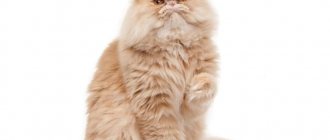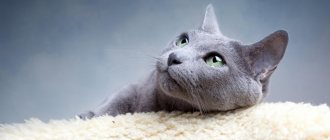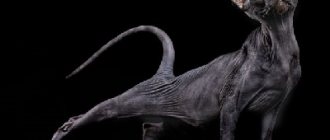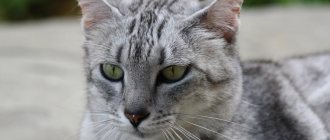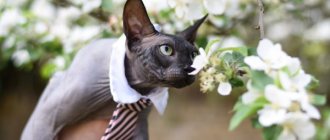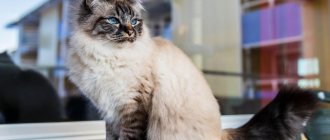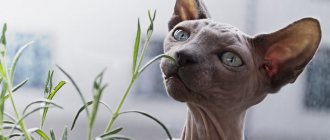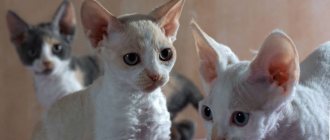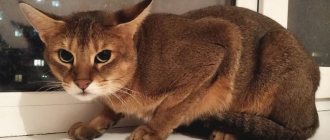History of the Chausie breed
The Chausie is a hybrid cat breed that is descended from the domestic shorthair cat and the marsh lynx, or, as it is also called, the jungle cat.
The history of the breed began long before the launch of targeted selection of Chausie. It is not known for certain what breed of cat became one of the first Chausie, but breeders have definitely established that the second parent of the cat is the swamp lynx. From her, the Hausie, as the breed is also called, received an amazing ability to adapt to absolutely any conditions.
Chausie is a hybrid cat
The name of the breed - Chausie - comes from the Latin name of its wild parent - Felis Chaus.
In Egypt, jungle cats and their hybrids have lived alongside people since ancient times and were used as virtuoso mousecatchers and hunters. Cats very similar to Felis Chaus are also depicted in ancient Egyptian frescoes. At a time when felinology did not yet exist, people promoted the breeding of chausie hybrids, which were strong and hardy, like jungle cats, but much less wild.
The first people to become interested in chausie were American tourists. While traveling in Egypt, they were surprised that real wild cats lived in houses next to people. Felinologists from the USA also became interested in this. In the early 1970s, they began closely breeding unusual cats.
The wild ancestor of the Chausie - the jungle cat - lives mainly in South Asia and on the banks of the Nile
Breeders had to face many difficulties, such as infertility in males and incompatibility with most domestic cat breeds. It turned out experimentally that the most suitable partner for Felis Chaus is the Abyssinian cat. Cats were also crossed with ordinary short-haired “noblewomen,” but this, like inbreeding (inbreeding), contributed to the degeneration of the breed.
Hard work with chausie was not immediately rewarded. In 1995, the breed was introduced to the TICA organization and received a standard. And in 2003, the Chausie became a full-fledged breed.
Pros and cons of the breed
There is a lot to love about these amazing animals. People who are lucky enough to become owners of Chausie pets emphasize their advantages:
- outer beauty;
- calmness, nobility;
- getting along with people and other animals;
- high intelligence, learning ability;
- good adaptive qualities;
- low maintenance requirements;
- friendliness, ability to show tenderness;
- attachment to the owner.
Chausie F2
The disadvantages include the high cost of animals, although true connoisseurs of this breed understand that it is completely justified. This is a rare breed, and there are certain difficulties with breeding exotic cats. Breeders have to spend a lot of money on the maintenance and veterinary care of producers. Another disadvantage is that only the owner of a private house or large apartment can afford to maintain a chausie.
Standard chausie
The standard describes the Chausie as a very large cat (females - 10-15 kg, males - 13-16 kg). Breed standard:
- Head. Small, wedge-shaped, full face of medium width.
- Cheekbones are high, sharp, long.
- The long muzzle balances the cheekbones and is complemented by a smooth and defined contour.
- Size allowed is medium to small.
- The forehead is long, sloping, ending in a slight bulge above the eyebrows.
- The ears are high, large, set close and slightly at an angle.
- It must be long and must balance the cheekbones.
- The torso is long, lean, with a deep chest. Rectangular in shape.
- The coat is short or slightly elongated. The length must be sufficient for correct ticking (color).
- Brown Ticked Tabby. The base of the hair is mouse-colored, the base color ranges from sandy to reddish-golden.
- The base of the hair is mouse-colored, then dark and light stripes alternate. The tip of the hair is always dark.
Photo gallery: Chausie colors
The brown ticked tabby is the most common type found in Chausies.
Black ticked tabby (black ticked tabby) darker than brown
Black grizzly ticket tabby (black grizzled ticket tabby) - color inherited from the Chausie from a wild ancestor
Black grizzly can be either brownish or black. Black solid looks presentable and luxurious. Black grizzled ticked is an exclusive color.
Silver ticked is the rarest color of the Chausie.
Branches of the breed
The behavior and appearance of the Chausie is influenced by the generation to which the cat belongs. Generation is designated by the letter F (branch) and a number. Shows the percentage of Felis chaus blood in the cat's blood.
- F1. First generation. The content of wild blood is at least 50%. Direct descendant of Felis Chaus.
- F2. Second generation. At least 25% of the blood is Felis chaus. Direct descendant of Chausie F1.
- F3. In the third generation there must be at least 12.5% jungle cat blood. Direct descendant of Chausie F2.
- F4. In this generation of Chausie, the percentage of Felis Chaus blood is at least 6.25%. Direct descendant of Chausie F3.
- F5,6,... Subsequent generations of Chausie contain less than 3.12% wild blood.
The most similar to the jungle cat are the 1st and 2nd generation Chausie cats. Chausie F1 is the most “wild” in character, but is still a pet. The higher the generation index, the more dissimilar in character the Chausie becomes to a wild cat. The size also depends on the generation. Some F1 cats reach 18 kg. The less wild blood a Chausie has in its blood, the smaller the cat will be.
Cats and cats 3,4,5, etc. generations are already very little similar to Chausie, therefore they do not represent the same value as cats of the 1st and 2nd generations.
Photo gallery: branches of the Chausie breed
F1 Chausie is the closest relative of the jungle cat F2 Chausie may already resemble an Abyssinian cat more than its ancestor
F3 Chausie still looks like a jungle cat
F4 Chausie looks beautiful and unusual F5 Chausie is the least similar to a jungle cat
Chausie is a cat whose photo will not leave anyone indifferent
Cats of this breed seem to be specially created to pose in front of camera lenses. There is so much grace in their movements! How expressive are their intelligent eyes! Anyone who has ever seen a photo of a Chausie will definitely want to meet this animal in person, but getting this cat is not so easy.
Even photographing chausie at exhibitions is not always allowed. Magazines negotiate with nurseries or owners about photo sessions, giving away a decent amount of money.
Health and illness
Chausie is distinguished by truly heroic health. Although the cat is heat-loving, it is not afraid of light frosts and does not get sick from the slightest draft. Chausie also has quite sensitive digestion. The only disease these cats are prone to is obesity.
Obesity
Obesity in the Chausie occurs due to its exorbitant appetite. Chausie can literally eat non-stop. The owner needs to stop begging, otherwise the cat will quickly turn not only into a kind of ball on its paws, but also into an eternally hungry meowing tail that does not disdain to steal food from the owner’s table.
Symptoms of obesity:
- The cat's weight is 20% or more higher than normal.
- Severe shortness of breath with little activity.
- Mobility problems.
- Inability to feel the ribs or spine through the fat layer.
Chausie loves to beg, but he can be weaned from this habit by simply ignoring the behavior
What causes obesity:
- Genetic predisposition.
- Uncontrolled eating.
- Hormonal disbalance.
- Lack of sufficient physical activity.
Obesity is much easier to prevent than to cure. To do this, the cat must be provided with maximum physical activity and proper, balanced feeding. But if the cat does get sick, then treatment involves diet, physical activity and, if necessary, taking hormonal medications.
Character and behavioral characteristics of the chausie
Chausie is a real perpetual motion machine. This cat, thanks to its relationship with the active Abyssinian breed and the physical endurance inherited from Felis Chaus, can run and play all day long. On the scale of cat activity, a Chausie would score all eleven out of ten. The first generation of chausies is especially active; they usually require the construction of a separate enclosure. Other generations can adapt to life in a large apartment, provided they take daily walks in nature. However, a small problem can be the curiosity of the chausie - left at home alone, the cat will not leave a single corner unexplored.
Oddly enough, the Chausi inherited activity from the Abyssinian cat, and poise from the jungle cat
The Chausie is very friendly towards most domestic animals. Of course, this does not apply to hamsters, guinea pigs, fish and other small animals - the Chausie perceives them as prey or a toy. But dogs or cats are great company for Chausies. The cat's sociability and unusual habits make it possible to make friends even with chained dogs. But people are of particular interest to the Chausie. They are devoted to only one owner, and communication with him is very important for the cat. Chausie usually does not like to sit on laps or be petted a lot, but with his whole appearance he shows how much he wants to communicate and play.
Chausie children are treated quite loyally, but still you should not leave them alone with the kids: the animal’s wild habits can appear at any moment.
Chausie becomes so attached to his owner that he is able to notice and remember the slightest manifestations of feelings in human facial expressions, movements, and tone of voice. Some Chausie owners say that the cat could guess the owner’s thoughts even before they were spoken out loud. Chausie also truly cares about its human and protects him from danger.
Chausies love active games and walks in the fresh air.
With the help of competent socialization, the Chausie turns into an unusually balanced and intelligent animal. These cats are not afraid of almost anything. In addition, Chausie carefully care for their fur. If from the first day you show your cat what is allowed and what is not, she will never cross the boundaries of what is permitted. Chausies are also very intelligent and can be easily taught tricks and commands. The cat's natural curiosity will also help in the learning process. But the first generation Chausie has a small problem with upbringing: these cats are very difficult to train to the litter box.
Reviews about the breed
I never thought that I would have a pet. Especially, I didn’t think that it would cost as much as a mink coat... Chausie is a cross between a wild swamp lynx and an Abyssinian domestic cat, which is where the wildness and color of the Abyssinian come from in this breed. The weight of such a cat can reach 15 kg. At first my choice was a Bengal cat, an animal a la a tiger cub. But when I saw Chausie live, it was indescribable. The most beautiful domestic predator! The cat is so beautiful! She is very smart and never lets her claws out at her owner. The furniture remained untouched, as did my hands. Very energetic, ready to play with her favorite toy all day long! A very unexpected feature of this breed: when it runs around, it begins to breathe like a dog, opening its mouth and sticking out its tongue. Plus, this cat doesn't meow! Chausie brings so many positive emotions! Her face shows her every mood, she is very funny. From the beast she has tufted ears and powerful fangs, with which she chews pieces of beef and chicken legs. The wild coloring of my huntress gives her an additional animal charm.
pgs150
https://otzovik.com/review_4267563.html
The cat was given to us when she was 3.5 years old. When she went on a spree, she began to mark everywhere like a cat, so they quickly sterilized her. In its normal state it always goes in the tray, you can put it anywhere and there will be no problems. She is kind and affectionate, but does not like to sit in her arms. There are scratching posts, but besides them, it tears up the wallpaper, the bed, or anything else that gets under its paws (backpack, bag, ...). He loves to drink water from the tap, he can sit in the sink and sit there, the same with the bath. Loves to walk on a harness. But you won't get far with her. She likes to walk slowly or just stand. There was a small child at home and when he cried, she came up, bit him and tried to drag him away. After they explained to her that this could not be done, while crying she began to bite the one next to the baby. She is a thief, she can steal a whole loaf of bread and hide it somewhere under the bed. She practically doesn’t meow, and that’s good, because her voice is nasty)) She sleeps during the day, and by night starts playing. He rushes around the apartment like a horse, demolishing everything in his path. She is practically not interested in toys, she needs a person. Attacks legs and arms. Grabs with claws and teeth. It bites very painfully. It can even be scary from her madly wild games. And she’s not aggressive; if she doesn’t like something, she’ll just leave. She has a little fur. In character and appearance it is very similar to the Abyssinian, only much larger. We love our animal very much))
Ssonny
https://otzovik.com/review_5613785.html
Reproduction and lifespan
Despite the excellent genes of wild ancestors, Chausie cats quickly become infertile, sometimes after the first generation, and cats last longer, and it is on them that the production of hybrids of subsequent generations is based. It is permissible to cross the Chausie with the Abyssinian breed and European shorthair cats of wild and ticked colors.
Breeding chausie is a difficult, troublesome and thankless task for ordinary hobbyists. This process is only possible for breeders, and even then not always. Imagine how you persuade a jungle cat, a predator from the wild, to pay attention to a proud Abyssinian “lady”?
After all, only this alliance produces a real Chausie kitten . Even if the union took place, you will receive 2-5 kittens worth their weight in gold. And that’s it, then you will either have to “ask” House again, or the breed will disappear in the third generation. The further you go, the lower the value of the kitten. Moreover, hybrid cats are no longer your help. So breeding Chausie is not for the weak.
If you are buying a Chausie kitten, be sure to get it from a reputable cattery. You will be offered a special contract, which will stipulate the issue of offspring, participation in exhibitions and other important issues. It is recommended to adopt a kitten at least 3 months old. They live on average 15 years.
Nutrition
Chausie has a special digestive system and a shortened intestine that cannot digest most plant foods, including cereals and legumes found in many foods. Because of these features, inherited from the jungle cat, the Chausie can be fed only with natural food.
What foods can be given to Chausie:
- lean beef;
- low-fat cottage cheese;
- quail meat;
- bird necks (crushed);
- rabbit meat;
- white sea fish;
- feed mice;
- day old chicks;
- raw quail eggs.
Some of the foods on the list are unusual, such as mice and chickens. But they are the ones that make up a harmonious and familiar diet for the chausie; they should be given at least twice a week. You can order chickens from a poultry farm; mice are sold in specialized pet stores as food for snakes. Cottage cheese is given to obtain calcium once or twice a week, 50–80 g.
Chausies should eat natural food from childhood
Chausie loves quail eggs, but you should not abuse them - 4-5 eggs a week will be enough. Meat makes up 80–85% of the chausie’s diet; it is recommended to alternate its varieties: the first day - beef, the second - rabbit, the third - quail, etc. The fish is given boiled or lightly boiled, two to three times a week.
It will also be useful to give Chausie vitamins for cats - this will compensate for the lack of nutrients.
What vitamins are suitable for Chausie:
- Vitamin tablets. 8 in 1 Excel Brewer's Yeast (brewer's yeast).
- Beaphar Kitty's Mix (for kittens).
- AniVital FeliDerm.
- Polidex Immunity up.
- Agrovetzaschita Radostin.
- Beaphar Laveta Super.
- Beaphar Duo Active Paste.
Chausie wool hygiene
The luxurious coat of the Chausie requires brushing twice a week. To do this, you will need to purchase a rubber brush, a combination comb and a slicker brush for the molting period.
- If the cat does not shed, brushing is done twice a week. First, use a combination comb to thoroughly comb the fur, starting from the neck and ending with the belly and paws. Then remove the remaining dead hairs with a rubber brush.
- During shedding, the fur is combed first with a comb, then with a slicker, and after that with a rubber brush.
Chausies are very fond of water, because their ancestor, the jungle cat, not only hunted, but also fished in small rivers and lakes. Therefore, if you have a pool or access to a clean body of water, allow your pet to swim as often as possible, this will improve his health. After swimming in open water, the cat will need to be washed with clean running water without shampoo. If there is no access to a reservoir, then you can arrange a chausie bath once every two weeks.
Washing the Chausie with shampoo should be done no more than 2-3 times a year - the cat is very clean.
What shampoos are suitable for Chausie:
- Perfect Coat Shed Control & Hairball.
- Shampoo “Gentle”.
- Perfect Coat Studio Concentrated Shampoo & Conditioner Tearless Cat by 8 in 1.
- Trixie Trocken Shampoo from Germany.
- Shampoo-conditioner "Papaya" Tropiclean.
- Shampoo for cats "Protein-lanolin" from Bio-Groom.
Maintenance and care
The Chausie cat breed does not cause much trouble in caring for. The silky coat with a full undercoat is not subject to intense shedding and only needs brushing with a stiff brush once a week. In summer, it is recommended to carry out the procedure more often, this will save you from the need to clean furniture and floors from carpets of dead hairs.
Reviews from Chausie owners indicate that mustachioed pets love to swim, as we have already mentioned earlier. For washing, it is better to use mild shampoos and only if the cat has heavily soiled its fur coat. Clean chausies lick their fur on their own, removing dirt; all you have to do is periodically maintain its beauty.
Standard grooming procedures also include cleaning ears, eyes, teeth, and trimming nails.
There are no problems with litter box training. Once you show your cat where the toilet is, she will remember the way to it. The best types of filler are wood, clumping and silica gel.
What to feed Chausie
Before you start planning your Chausie's diet, remember that animals have inherited a shortened intestinal tract. In this regard, fiber and plant products are difficult to digest, causing fermentation and bloating. Dry food is also not a suitable option.
The best food for chausie is raw meat (beef and rabbit). Chicken and quail can be given 1-2 times a week for variety. Representatives of the breed will not refuse fish - fresh or canned. Salmon, cod and tuna are suitable. It is recommended to introduce fish gradually to prevent unwanted allergic reactions.
Reference. Chausie will happily gnaw on tendons and boiled cartilage. Such products help clean teeth and are considered excellent sources of collagen.
Forbidden food:
- sweets;
- pickles, pickled products;
- legumes;
- river bony fish;
- whole milk (kittens can);
- pork;
- mutton;
- liver;
- nuts;
- mushrooms;
- eggplant;
- potato.
The optimal feeding frequency for adult cats is 1-2 times a day. After your pet turns one year old, arrange fasting days once a week. Chausas are quite gluttonous and prone to overeating, so your task is to control the portion size.
Health and how long they live
Chausies inherited excellent health from their ancient ancestors: cats hardly cause problems for their owners. However, no one has canceled regular veterinary examinations. We have already mentioned the exorbitant appetite of the representatives of the breed, which leads to excess weight gain.
For this reason, it is not recommended to leave food in a visible place, and pots and pans without lids. Before you know it, the chausie will jump on the stove or table and begin to deliciously devour the chicken prepared for lunch.
Upbringing
The Chausie cat has extraordinary intellectual abilities, so training and education give owners only positive emotions. From the first day, show the kitten where there is a tray, bowls for water and food, a scratching post and a place to sleep. Chausie thinks quickly and follows directions clearly.
Representatives of the breed can be taught “dog” commands: “Sit!”, “Lie down!”, “Voice!”. Cats know how to give a paw, tragically “die”, bring slippers in their teeth, dance and jump through a hoop.
Cats love to learn, which makes the training process easier. Don't forget to support your pet's enthusiasm with his favorite treat. In addition, Chausies become very stubborn when they need to achieve a goal. Therefore, you can repeat the same command with them until it is stored in memory.
Care for claws, teeth, eyes, ears
Caring for the ears, teeth and eyes of the Chausie is not too different from caring for other domestic cats:
- The ears are cleaned every five to six days with special drops for cleaning the ears. Place a few drops into your ear and gently massage the base of the ear for 2-3 minutes.
- The eyes should be cleaned daily with a cloth soaked in warm water. You need to wipe in the direction from the inner corner to the outer.
- Teeth are cleaned using a silicone toothbrush and toothpaste for cats. The joints of the teeth and the area near the gums are most thoroughly cleaned.
- A simple scratching post will not work for Chausie's claws: they will need a wooden log. Nails need to be trimmed as they grow - buy a nail clipper for this. The claw is cut slightly at an angle, so that the cut from the front resembles the tip of a nail and does not affect the pink sensitive part of the claw. If the claw bleeds after trimming, treat the wound with peroxide.
Chausie claws are powerful and long, so anti-scratch treatments are ineffective for them.
Breeding and organizing a chausie nursery
Breeding Chausie is allowed only to people with a felinologist diploma and who understand all the nuances of the breed. Therefore, before taking on this difficult task, you need to attend felinological courses and consult with professionals in this field. It would also be a good idea to spend some time breeding Abyssinian cats, since breeding Chausie cats is allowed only in professional nurseries with responsible breeders.
Breeding Chausie has several disadvantages:
- Firstly, cats of this breed are extremely expensive. In order to buy a pair for breeding, you will have to shell out at least half a million rubles, and to purchase a jungle cat, with which it is best to start breeding Chausie, you will have to shell out at least eight hundred thousand.
- Secondly, this is a very risky business, since the breeder faces many difficulties: infertility and mutations in kittens, inbreeding and many others.
- Thirdly, this business is designed for a very narrow category of people who can afford to spend 200,000 rubles or more on a cat.
But if you have sufficient funds, knowledge and experience and are not afraid of difficulties, then it is quite possible to try. But remember: cats must be purchased only from a specialized nursery with all licenses.
The Chausie breeder will have to work hard to get a cat that fully meets the standard.
Mating
For a novice breeder, the best choice would be an F1 generation cat. Breeding chausie involves many difficulties and nuances:
- Chausie cats up to the third generation are born infertile. Therefore, if you want to buy a couple of studs, then you need to take an F1 female and an Abyssinian cat.
- When you have already gained experience, you can also buy a reed kitten, always a male, since a wild female will not let a domestic cat near her. It should be crossed with an Abyssinian cat. A jungle cat may not agree to a proposed mate, so you may have to go through several females.
- The F2 female is also bred to an Abyssinian cat.
- Make sure your cats are blood type compatible. Cats have only two groups: A and B. Cats A and cats B are compatible with any partner, cats B are mated only with males B, males A are mated only with females A.
First generation Chausies love to hunt
Pregnancy
Some features of pregnancy during breeding should also be taken into account:
- The pregnancy of an Abyssinian cat from a jungle cat will last about 67–70 days, and she will bring two or three kittens. Moreover, some of them may not meet the standard and look more like an Abyssinian cat than a wild cat.
- A female Chausie F1 and F2 will give birth to about 3-4 kittens, which may also not meet the standard.
- Chausie males cannot have offspring until the third generation, so the boy can be sold under the F1 label if he is the son of a jungle cat and an Abyssinian cat; F2, if he is the son of an F1 female and an Abyssinian cat; F3, if he is the son of a Chausie F2 and an Abyssinian cat.
- Only Chausie females that fully comply with the standard are allowed to be selected for further breeding.
As you can see, breeding chausie is a very difficult matter. Only people who have the necessary knowledge and are ready to devote all their time and even their lives to chausie can achieve success.
Chausie needs an owner who can devote a lot of time to them
Note to the breeder
Before you start breeding Chausie, you need to obtain permission to breed Chausie and register the nursery.
- The breed is recognized only by TICA. Therefore, the nursery must be registered there.
- Each cat, both Abyssinian and Chausie, must have a breeding rating of at least “excellent” in the open category or a title certificate. You can get them at the exhibition.
- Each cat must have a confirmed pedigree.
- For each kitten, a birth certificate and a breeding sheet are issued, which is assigned a four-digit number. If you have a felinologist diploma, you can do this yourself.
- Chausies receive the same vaccinations as regular cats. Kittens receive a veterinary passport from 3 months.
Kinds
According to the officially accepted classification, this breed is divided into several special subspecies or, more correctly, groups, marked with the Latin F with the addition of a serial number from 1 to 5. Moreover, the serial number of the marking indicates the percentage of blood content of the “dad” - the aforementioned jungle cat: the higher this number, the lower its percentage.
Thus, the first generation F1 hybrids retain almost the entire set of external characteristics and characteristic features of a wild predator.
